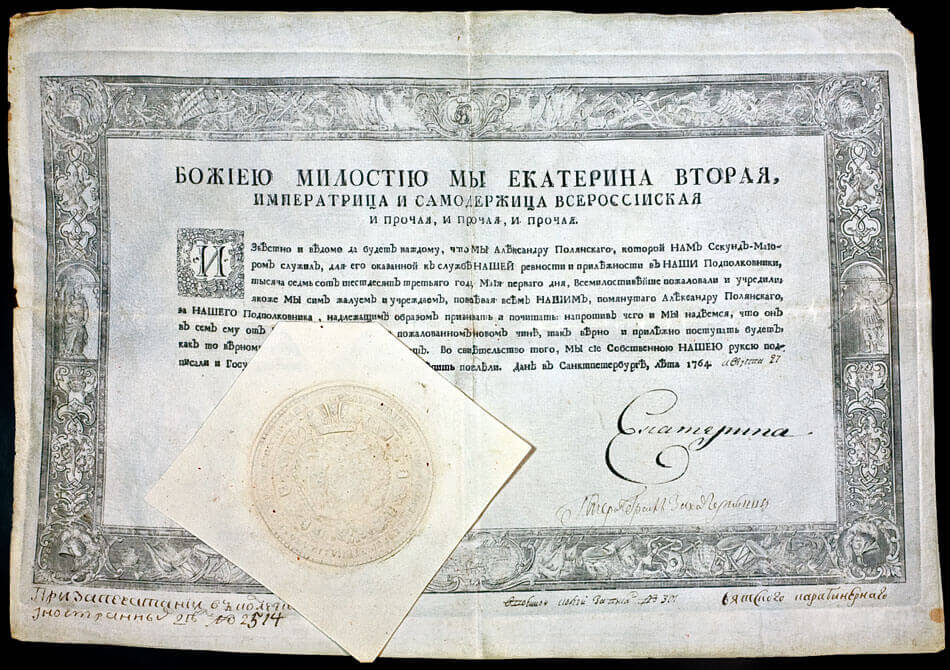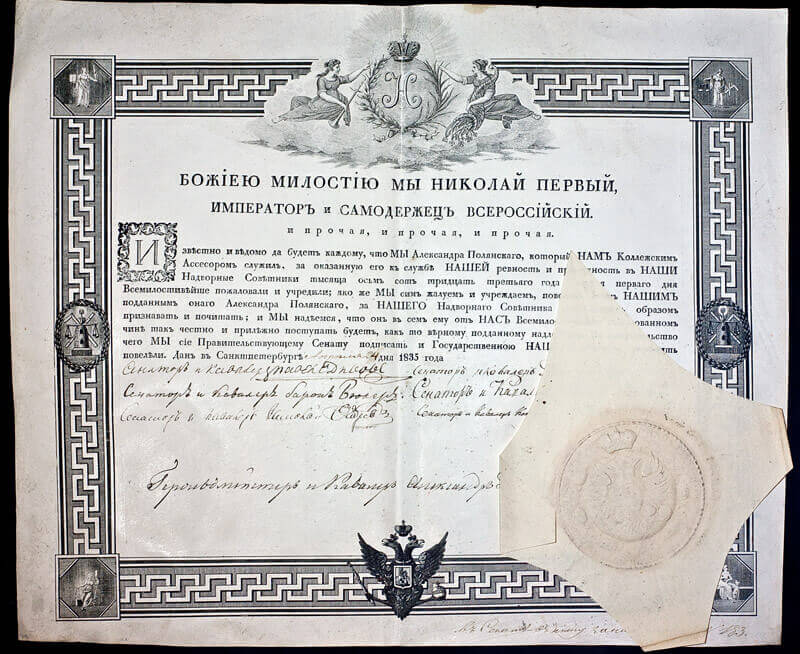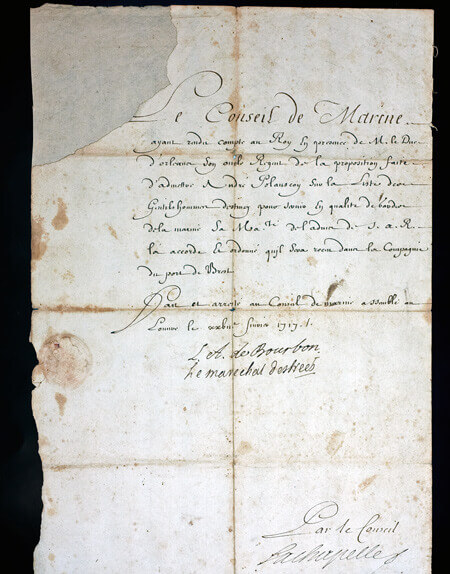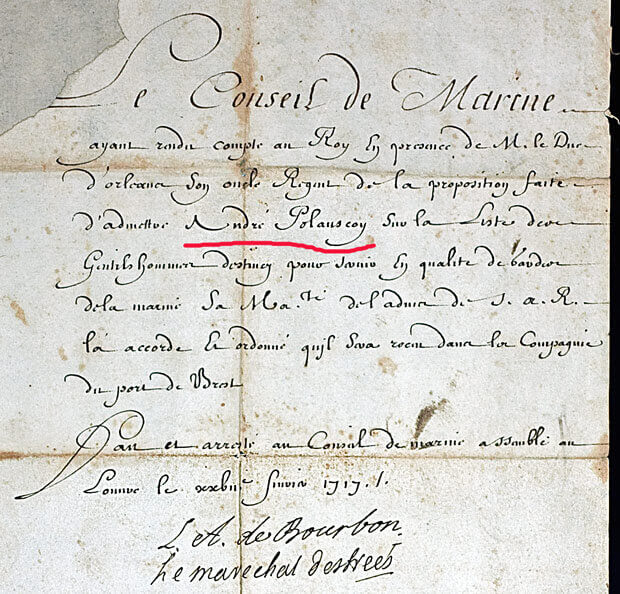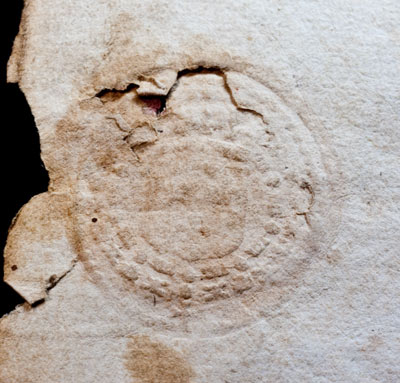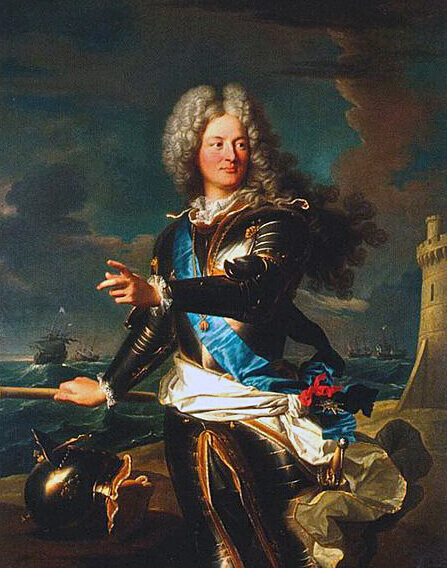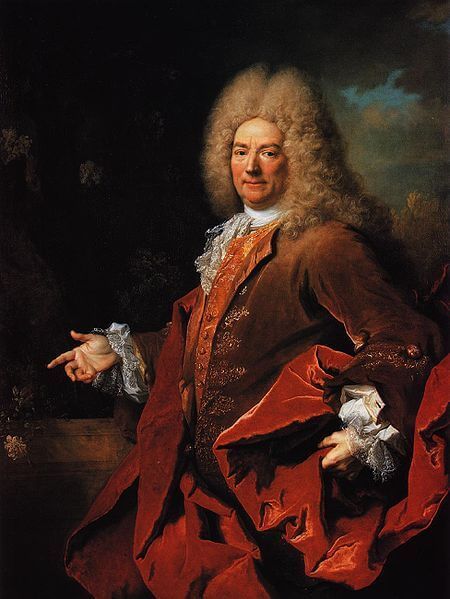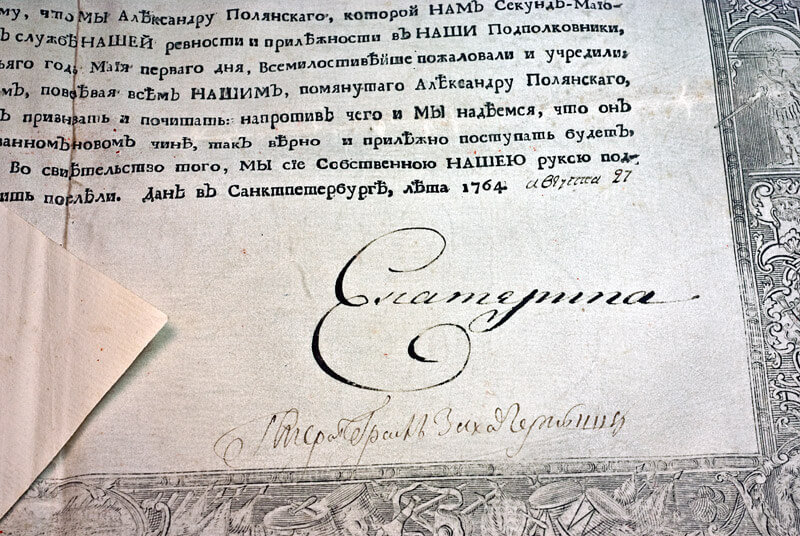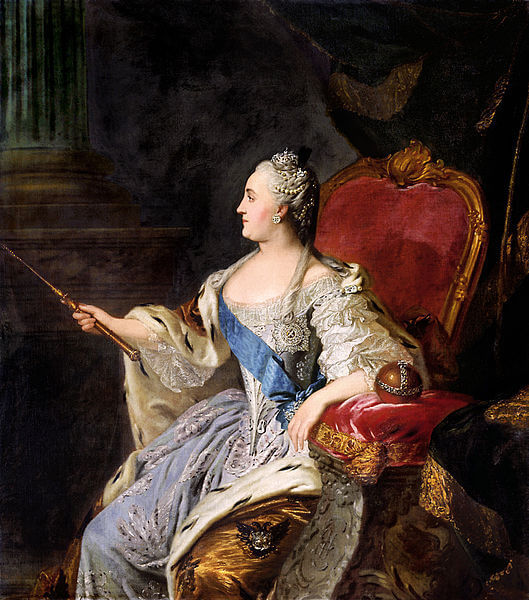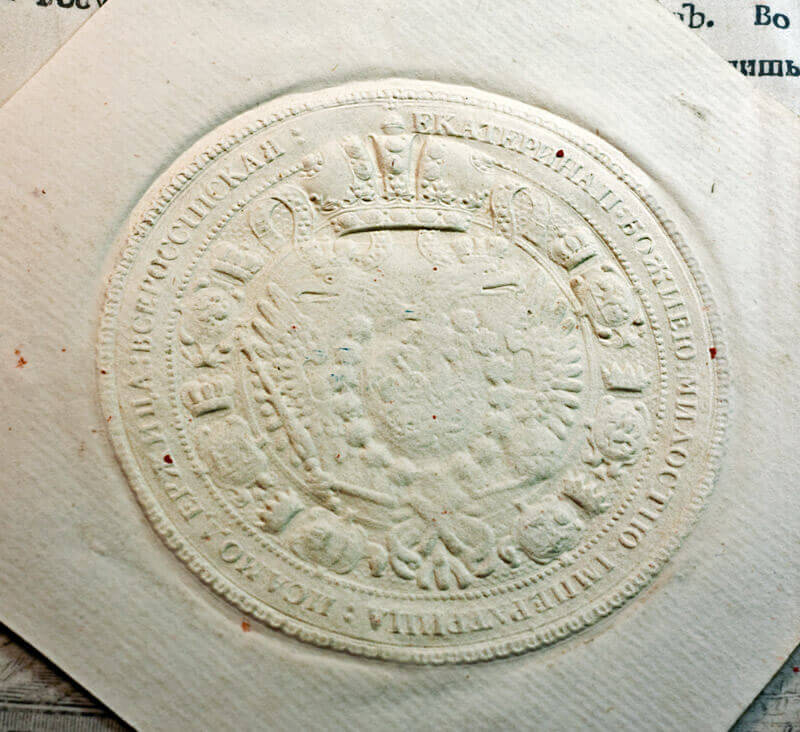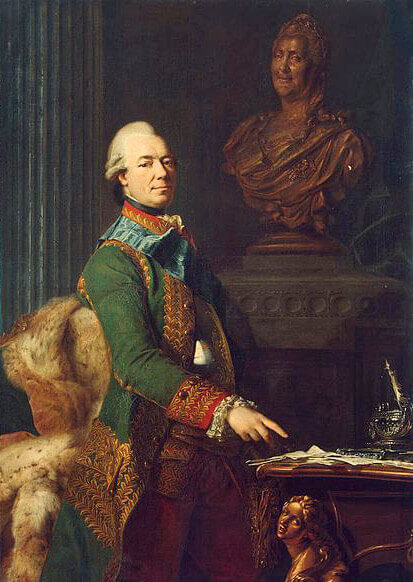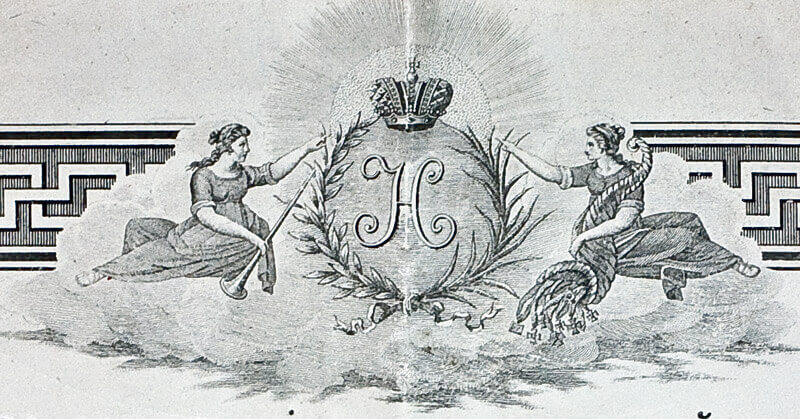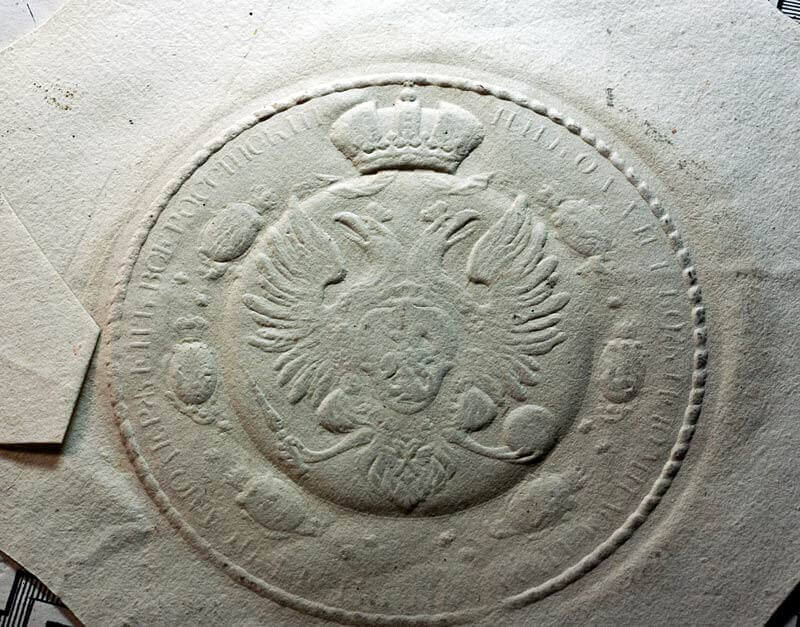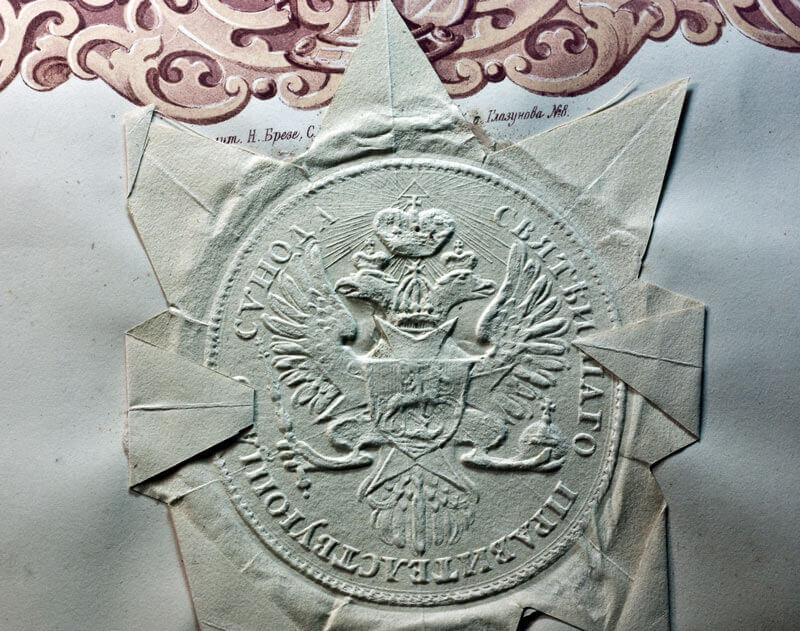A group of four important historical documents from the archive of the Polyansky family,
including an 18th century military diploma (patent) signed by Catherine II the Great, Empress of Russia.
* * *
No. 1
An important historical document from 1717, related to the early history of the Russian Navy.
The document was issued by the Council of the French Navy and states that a nobleman Andre Polanscoy is admitted to His Royal Majesty’s Navy as a garde-marine and assigned to the port of Brest.
The document is dated February 17, 1717 and was signed at the Louvre by Louis Alexander de Bourbon, Chef du Conseil de la Marine (Chief of the Council of the Navy)
and Victor-Marie d’Estrees, Marshal of France, member of the Conseil de la Marine.
The document is stamped with a French royal seal and has two notes on back, both dated 1717 – one by a controller of the Royal fleet in the port of Brest, another of Toulon.
Louis Alexandre de Bourbon, Count of Toulouse (1678-1737),
was a legitimated son of the French Sun King Louis XIV and his official mistress Madame de Montespan.
At the age of five – Grand Admiral, during the War of Spanish Succession commanded the French fleet, Minister of the Navy.
Victor-Marie d’Estrees (1660-1737),
in the Navy since the age of seventeen, commander of the Mediterranean fleet, Marshal of France (1703), appointed mentor to Louis Alexandre de Bourbon (1704),
during the Regency of Duke of Orleans – member of the Marine Council.
The Russian Navy was born in 1696 when Tsar Peter I first employed the newly built 2 warships, 4 fireships, 23 galleys and 1300 strugs in the battle against the Turks during the Second Azov campaign.
The Russian Navy expanded dramatically during the Great Northern war against Sweden (1700-1721).
During the reign of Peter I, the majority of the future Russian Navy officers, after graduating from the Navigation School of St. Petersburg, were sent to Western European fleets to acquire practical experience.
Andrei (Andre in French) Polyansky was one of those officers. Interestingly enough, after the officers returned to Russia, Tsar Peter would personally examine them for their marine skills.
Those who failed, were sent to the ships as seamen. Andrei Polyansky passed the test.
Here is his brief biography published in the late 19th century Russian biographic dictionary by A. Polovtsev:
Andrei Ivanovich Polyansky, admiral, in 1715 was brought from the Moscow marine school to St Petersburg marine academy and in 1716 was sent to France to acquire navy experience, returned to Russia in 1725 and received the rank of junior lieutenant, and lieutenant in 1726. As a lieutenant, he commanded various ships which were sailing to Germany. As a captain (1733) and adjutant to Admiral Gordon, Polyansky commanded a frigate during the siege of Danzig (1734). Then he became Chief of the Moscow Admiralty for 12 years. He was a commander of various frigates on the Baltic sea. Polyansky received the rank of a counter (rear) admiral (1751) and served as commander in chief of the Kronstadt port. At the Court of Empress Elizabeth (1753), he received St. Anna Order in 1754. Polyansky was awarded with the rank of vice admiral in 1757. Then he was the commander of the port of Revel (Estonia) and later Governor of Revel. During the Russo-Prussian war, he was the commander of the Russian Navy. Polyansky was awarded with the Order of St. Alexander Nevsky (1760). Lastly, he became an admiral and the Commander of the Baltic sea fleet in 1764 and died the same year.
ПОЛЯНСКИЙ АНДРЕЙ ИВАНОВИЧ — адмирал; в 1715 году был привезен, в числе других молодых дворян, из Московского Морского училища в С.-Петербургскую Морскую Академию и в 1716 г. был отправлен во Францию, для усовершенствования в морском искусстве, в 1725 году возвратился в Россию и 6-го ноября произведен был в унтер-лейтенанты, а в 1726 г. в лейтенанты; в этом чине в течение нескольких лет он состоял начальником пакетботов, ходивших в Любек и Данциг. Назначенный, затем (13-го января 1733 г.), в генеральс-адъютанты к адмиралу Гордону, П. находился при нем в 1784 г., во время осады Данцига командовал фрегатом “Арондель” и по сдаче французских войск отвозил пленных сухим путем в Петербург, получив еще 1-го июля 1733 г. чин капитана. В 1735 г. П. ходил с командой в Архангельск и в следующем году был назначен начальником Московской Адмиралтейской Конторы, в каковом звании пробыл 12 лет, командуя различными фрегатами на Балтийском море и крейсируя у берегов Голландии (1743 г.), у Красной Горки (1744 г.), 5-го сентября 1751 г. произведен в контр-адмиралы, 16-го сентября 1751 же года получил назначение на пост главного начальника Кронштадтского порта; в 1753 г. был вызываем в Москву к Императрице Елизавете, при которой и состоял, будучи награжден в 1754 г. орденом св. Анны; в 1755 г. П. определен был начальником флота, назначенного в крейсерство, а возвратясь, снова занял пост главного командира Кронштадтского порта и, произведенный 5-го мая 1757 г. в вице-адмиралы, в сентябре назначен был начальником Ревельской эскадры и отправился с флотом для блокирования берегов Пруссии, откуда, однако, возвратился на Ревельский рейд уже в конце октября 1757 г., так как был назначен (12-го сентября) и. д. главного командира, а затем — Ревельским губернатором. В мае — сентябре 1758 г. он на корабле “Северный Орел” крейсировал у о. Готланда и Борнгольма, а в 1759 г. назначен был главным командиром всего русского флота и получил повеление крейсировать у берегов Померании и блокировать их; 1-го января 1760 г. П. награжден был орденом св. Александра Невского, командовал флотом при осаде и блокаде Кольберга в 1761 г., плавал с флотом у берегов Пруссии и осенью получил приказание быть главным командиром в Ревель. Произведенный 4-го мая 1764 г. в адмиралы и назначенный командиром Балтийского флота, П. умер 17-го октября 1764 года.
Общий Морской список, т. II, стр. 334—356; Ф. Ф. Веселого. Материалы для истории русского флота; его же, “Описания дел архива Морского Министерства”; П. Баранов. “Опись Высоч. указам и повелениям, хранящимся в архиве Правит. Сената”, т. III; В. Н. Берх. “Жизнеописания первых российских адмиралов”, ч. III, СПб. 1834, стр. 65—75; “Кронштадтский Вестник”, 1867, № 4, стр. 3—4. {Половцов}
Полянский, Андрей Иванович — адм-л. В 1716 г. по окончании курса в Морск. академии отправлен гардемарином во Францию для усоверш-ния в морск. науках. В 1725 г., возвратившись в Россию, произв. в у.-лейт-ты “без баллотир-ния и по экзаменации”. Командовал пакетботами “Почт-Ваген” и “Курьер”, плававшими между Кронштадтом и Данцигом. В 1733 г. назн. командиром фрег. “Принцесса Анна”. Посланный с командой сух. путем в Архангельск, вернулся оттуда на корабле “Город Архангельск” командиром. В 1737 г. назн. на должность начальника моск. адмиралт. конторы. В 1739—1742 гг. плавал в Балт. море, командуя фр-тами “Гектор” и “Кавалер” и кораблем “Азов”. В 1743 г., командуя кораблем “Ревель”, крейсировал у о-ва Гогланд в составе рус. флота под ком. адм. гр. Головина для наблюдения за непр. флотом. 7 и 8 июня участвовал в перестрелке со шведск. флотом, после которой последний ушел, не приняв решит. сражения. Затем плавал на том же корабле в Балт. море до 1751 г., когда был произведен в контр-адмиралы и назн. гл. командиром Кронштадт. порта. Командовал практич. эскадрой в Балт. море, а в 1757 г. произв. в в.-адм-лы и назн. начальником ревельск. эскадры, с которой до конца окт. блокировал прусск. порты. В том же году назн. гл. командиром Ревельск. порта. В 1759 г. с ревельск. эскадрой конвоировал транспорт. суда, следовавшие к нашей действовавшей в Пруссии армии, и блокировал прус. порты совместно со шведск. эскадрой, которая находилась под гл. нач-вом нашего в.-адм-ла. В 1760 г. командовал флотом, участвовавшим в осаде той же крепости. B 1764 г. произв. в адм-лы, командовал флотом в Балт. море.; 17 окт. того же года скончался.
No. 2
A military appointment (diploma / patent) for the rank of Lieutenant Colonel of the Guards given to Alexander Polyansky in 1764.
The document is printed on a parchment 10 3/4 x 16 in. (27.3 x 39.5 cm).
It is signed by Empress Catherine II the Great and Count Zakhar Grigorievich Chernyshyov.
1763 portrait of Catherine II by Rokotov.
State wax seal embossed with Russian Imperial eagle and title of Catherine II.
Count Zakhar Chernyshyov (1722-1784), Minister of War during the reign of Catherine II.
Alexander Ivanovich Polyansky (1721-1818) a nobleman from the Penza region, began his military service in 1742 as an ordinary soldier in the Guards. He received the rank of a 2nd Lieutenant in 1751 and Lieutenant of the Chernigov infantry regiment in 1755. He was a fligel-adjutant in 1756. In 1760, Polyansky received the rank of a Major in the Life Guard Cuirassier regiment and in May 1763 became a Lieutenant Colonel in the same regiment. He retired from the military service with the rank of a Colonel in 1765.
In 1767 and 1768, Polyansky was a deputy in the committee, established by Catherine II, on the rights of nobility.
In 1765, Polyansky married Countess Elizaveta Vorontsova a former official mistress of Emperor Peter III, husband of Catherine II who was killed after the court coup of 1762.
Catherine II did not persecute the mistress of her former husband after she took the throne.
In 1774, Catherine II even was the godmother of Vorontsova’s and Polyansky’s son – Alexander (his 1791 military appointment is next piece on this page).
No. 3
The following document is a diploma (patent) for the rank of a Court Councilor ( Надворный советник ), a civilian rank in the Russian Empire which corresponds with the rank of a Lieutenant Colonel in the army. It was given to Alexander Polyansky by the State Senate on behalf of Emperor Nicholas I in 1835.
The diploma is printed on a parchment paper 14 x 16 3/4 in. (34.8 x 42.3 cm) and is decorated with a crowned cipher of Nicholas I, Imperial eagle,
allegorical figures and Greek pattern border, with attached wax seal of the Russian Empire.
The document is signed by six senators.
No. 4
A “blessing” issued by the Synod in St. Petersburg and signed by Isidor Metropolitan of Novgorod and St. Petersburg (1799-1892), undated, circa 1870, acknowledges the donation given by the landowner
Alexander Polyansky to the church of the village of Makarovka.
A lithograph print 12 x 18 1/2 in. (30 x 46.3 cm), decorated in Russian medieval style with attributes of the Russian Orthodox Church.
Seal of the Synod with Imperial eagle and Grand Maltese Cross.

